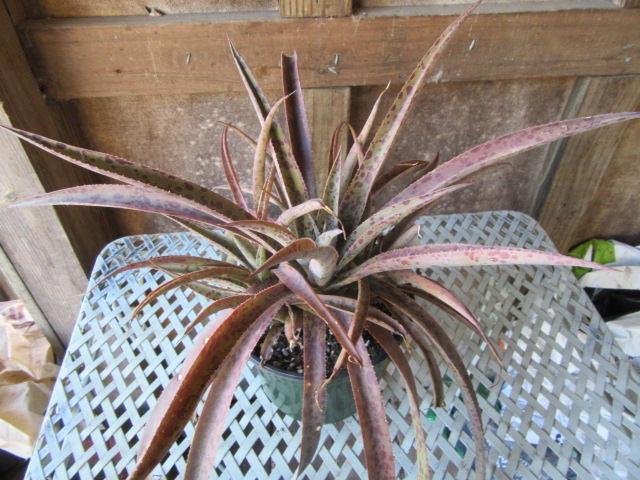
Agave (Syn. xMangave) ‘Pineapple Express’ at 10″ tall x 18″ wide on 10-23-23.
Hello everyone! I hope tis post finds you well. The temps have been great and we are getting some rain. We have made it through most of October without a dreaded “F”, but this weekend will be very cold. Since it would be raining all week, I decided to bring the plants on the back porch inside on the 23rd before they got wet. As usual, most of them will get measured and photographed. I started with the back porch on Monday the 23rd then moved to the front porch and worked until it was too dark to take photos then finished on the 24th.
In all, despite the heat and drought, the plants on the back porch did quite well. I kept the cactus and succulents on the front porch last summer, but I put the plants on this post on the back porch for 2023. There were no issues with sunburn or anything else.
As usual, you can click on the plant’s name to go to their own pages.
The Agave ‘Pineapple Express’, top photo, has been on the back porch this summer for a change. It changed colors in the sun, but it did very well and has grown to 10″ tall x 18″ wide. It is online as xMangave ‘Pineapple Express’, but as previously mentioned, xMangave is a synonym of Agave. I am curious, though, since Manfredia is now a synonym of Agave, does the patented name xMangave ‘Pineapple Express’ actually become Agave ‘Pineapple Express’? Hmmm…
<<<<+>>>>

Callisia repens (Bolivian Jew) on 10-23-23, #967-3.
Of course, the Callisia repens (Bolivian Jew) isn’t a cactus or succulent, but it is a neat plant and it likes the full sun on the back porch. I have grown these for a few years and they grow and grow until I bring them inside for the winter. They usually fizzle out after that… Their stems take root in every pot around them and would probably be best suited in a hanging pot. Maybe next year…
<<<<+>>>>
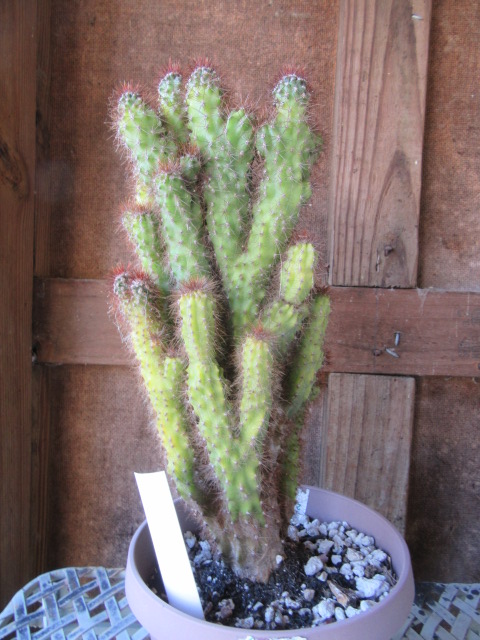
Cereus repandus f. monstruosus ‘Rojo’ at 10 3/4″ tall x 4 1/2″ wide on 10-23-23.
The Cereus repandus f. monstruosus ‘Rojo’ had made it through its sixth summer and is now 10 3/4″ tall x 4 1/2″ wide (at its widest part). It is a “monstrose” form of the Peruvian Apple Cactus… It is a really neat cactus and one I should buy more of. No two monstrose forms are alike.
<<<<+>>>>
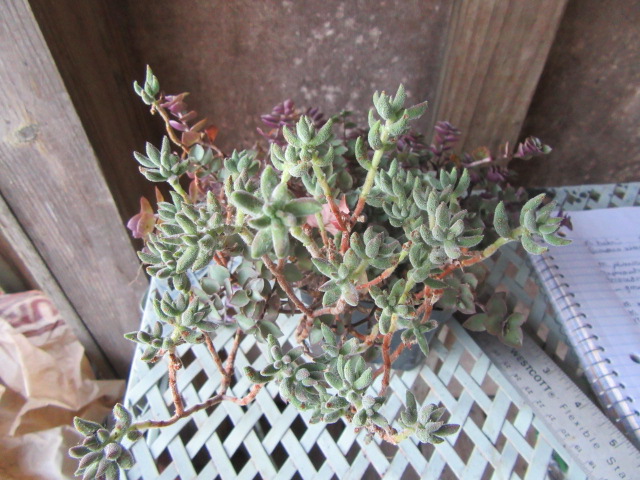
Delosperma echinatum (Pickle Plant) on 10-23-23, #967-7.
I have grown a Delosperma echinatum (Pickle Plant) for a few years but I haven’t had a good one… I must admit, this one has done much better despite its pot being invaded by its neighbor Callisia repens… The pot is half and half. I brought the pot inside and put it on the kitchen windowsill. We’ll see which one dies first. I haven’t been able to overwinter a Pickle Plant either… No page for this one.
<<<<+>>>>
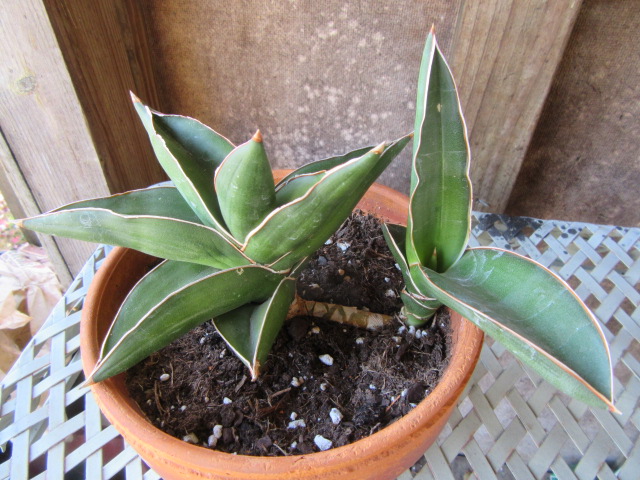
Dracaena hanningtonii ’Samurai’/‘Dwarf Samurai’ at 4 1/2″ tall x 6 1/2″ wide, the offset 4 1/2″ tall x 4 5/8″ wide on 10-23-23, #967-8.
Hmmm… This Dracaena hanningtonii ‘Samurai’/’Dwarf Samurai’ has grown to 4 1/2″ tall x 6 1/4″ wide. I noticed when I put the plants outside in May it was sprouting a kid… Now, I brought this plant home in January 2020 when it was 3″ tall and it has grown 3/4″ every year. This kid comes along and grows to 4 1/2″ tall x 4 5/8″ wide in just a few months!!! Actually, I fudged a little because the parent is actually only 4 1/4″ tall, but I couldn’t let the kid get the advantage…
If you look for one of these neat plants, it may be labeled as Sansevieria hanningtonii with a cultivar name of ‘Samurai’ or ‘Dwarf Samurai’…
<<<<+>>>>
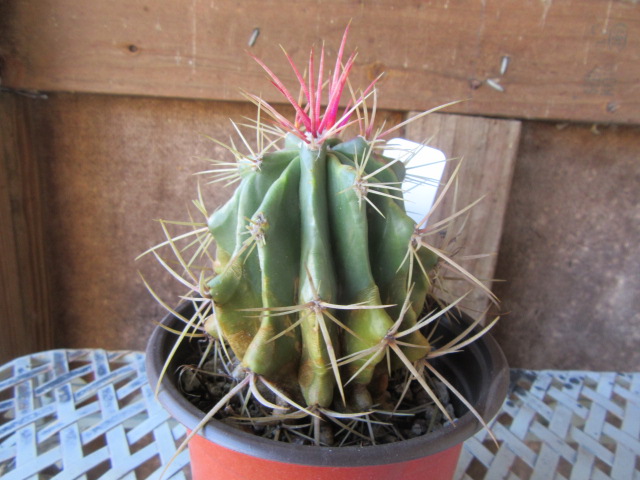
Ferocactus wislizeni (Fishhook Barrel Cactus) at 3 3/4″ tall x 3″ wide on 10-23-23, #967-15.
I have been wondering about the Ferocactus wislizeni (Fishhook Barrel Cactus) for a while… At one point I thought it was dying, but it always looks a bit pale toward the bottom. It has grown 5/8″ since last October to 3 3/4″ tall x 3″ wide. GOOD JOB Wisley!
<<<<+>>>>
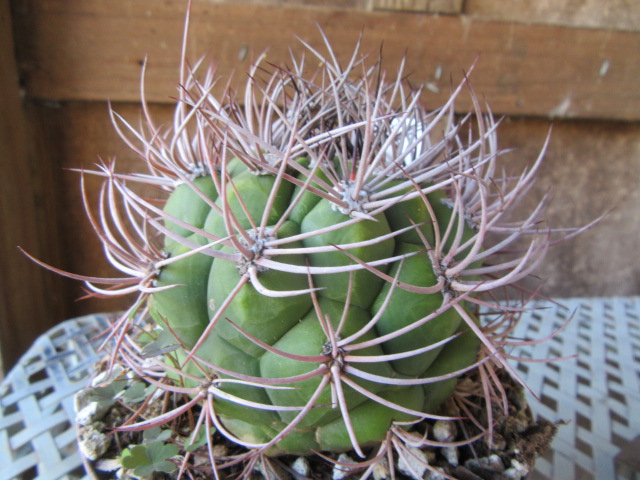
Gymnocalycium saglionis (Giant Chin Cactus) at 2 5/8″ tall x 3 1/2″ wide on 10-23-23, #967-18.
The Gymnocalycium saglionis (Giant Chin Cactus) has been a great plant since I bought home in 2019. It just takes its time watching everything going on around it without complaint. It has made it to 2 5/8″ tall, but shrunk a little around the waist to 3 1/2″. Normally, this guy has no complaints, but I promised him a new pot… Well, it fell apart while I was moving the plant to the table to take his photo. He just looked at me with a “?”…
<<<<+>>>>
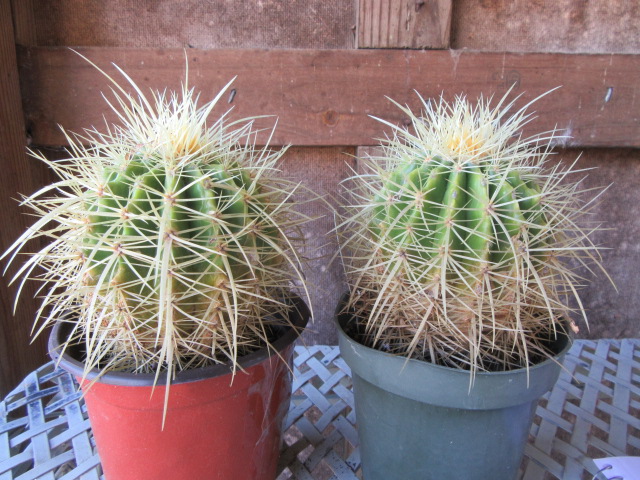
Kroenleinia grusonii (Golden Barrel Cactus), both at 4″ tall x 3 1/2″ wide on 10-23-23, #967-20.
Greater and Lessor Kroenleinia grusonii (Golden Barrel Cactus) have finally caught up with each other at 4″ tall x 3 1/2″ wide. Last year Lessor was a little bigger than Greater… You know they always try to fool me, but this time they were calm. Hmmm…
<<<<+>>>>

Mammillaria hahniana (Old Lady Cactus) at 5 3/4″ tall x 3 3/4″ wide on 10-23-23, #967-22.
Mammillaria hahniana (Old Lady Cactus) is looking great as always and has grown to 5 3/4″ tall x 3 3/4″ wide. It had a growth spurt last year while on the front porch growing 1 3/4″ in one year to 5 1/2″. I measured it again a month later and it shrunk to 4 3/4″. That’s normal since it didn’t have any water. You know, they swell up with water… 🙂 I really like this cactus and it is one of several of the older ones I have had since 2016.
<<<<+>>>>
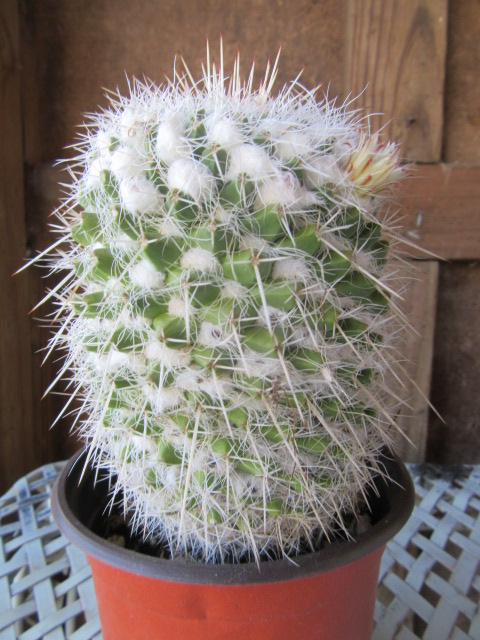
Mammillaria karwinskiana (Silver Arrows) at 5″ tall x 3 1/2″ wide on 10-23-23, #967-24.
The Mammillaria karwinskiana (Silver Arrows) is another great wooly Mammillaria that is easy to grow. It has reached 5″ tall x 3 1/2″ wide and was a mere 1 7/8″ tall x 2 3/16″ wide when I brought it home in 2018.
<<<<+>>>>
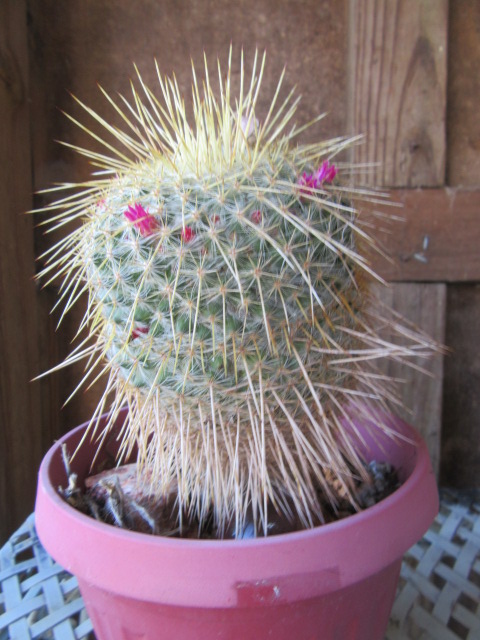
Mammillaria muehlenpfordtii (Golden Pincushion) at 5 1/2″ tall x 3 1/2″ wide on 10-23-23, #967-26.
The Mammillaria muehlenpfordtii (Golden Pincushion) is another great Mammillaria I brought home in 2018. I remember it lying on its side out of its pot on the clearance rack. It smiled so I brought it home. Its blue-green color, long golden spines, and club-shaped growth habit make it a great addition to the collection. It is now 5 1/2″ tall x 3 1/2″ wide and hasn’t done much leaning this past year. This is one of a few species that divide dichotomously, meaning it will divide. It may grow offsets, but that hasn’t happened yet either… Believe it or not, a piece of the hot glue used to attach a strawflower to this plant is STILL lower down on the plant…
<<<<+>>>>
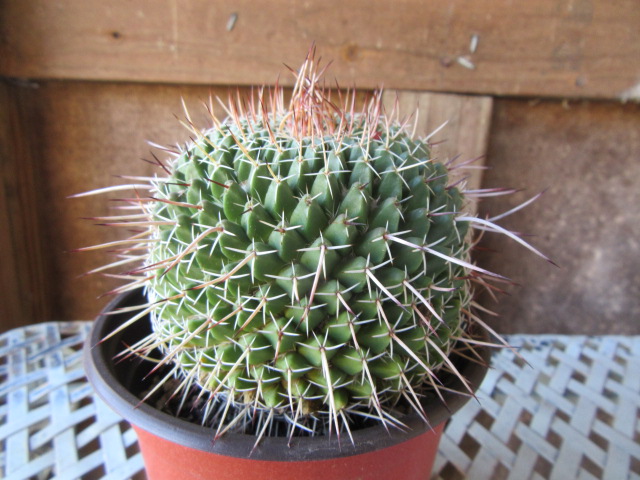
Mammillaria mystax at 3 1/2″ tall x 3 1/4″ wide on 10-23-23, #967-28.
Mammillaria mystax is a great companion that always looks great. It has been carefree and dark green since I brought it home in 2018. It was only 1 3/4″ tall then and has grown to 3 1/2″ tall x 3 1/4″ wide.
<<<<+>>>>
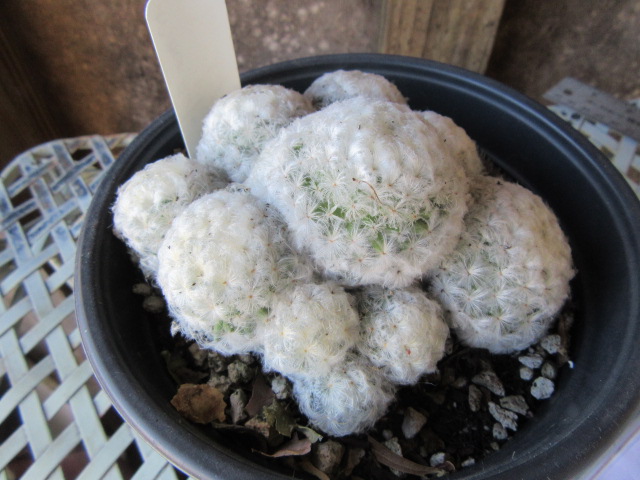
Mammillaria plumosa (Feather Cactus) at 2 1/2″ tall x 4 3/4″ wide on 10-23-23, #967-30.
The Mammillaria plumosa (Feather Cactus) has been a charmer for sure. I bought it from a seller on Ebay in 2019 and it came wrapped in toilet paper at only 3/4″ tall with a few offsets that measured a total of 2 1/4″ wide. The tallest in the center is now 2 1/2″ wide and the clump measures 4 3/4″ wide. It may look soft and cuddly, but it does have short spines…
<<<<+>>>>
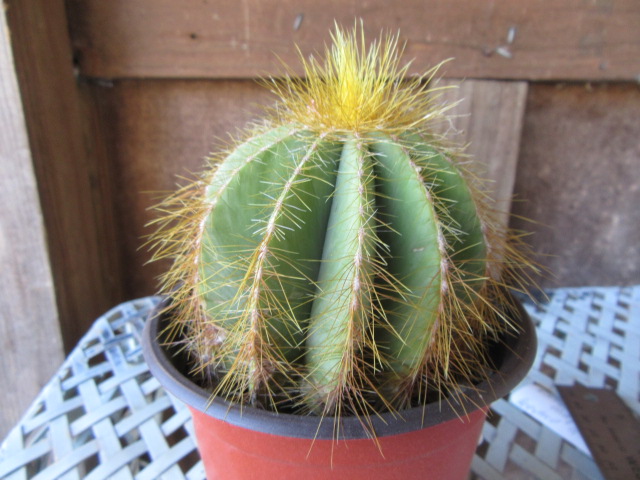
Parodia magnifica (Ball Cactus/Balloon Cactus) at 3″ tall x 3″ wide on 10-23-23, #967-32.
The Parodia magnifica (Ball Cactus/Balloon Cactus) is always neat with deep ribs, soft golden spines, and an odd hairdo. It was only 1 3/8″ tall x x 2 3/8″ wide when I brought it home in 2019 and is now 3″ tall x 3″ wide.
<<<<+>>>>
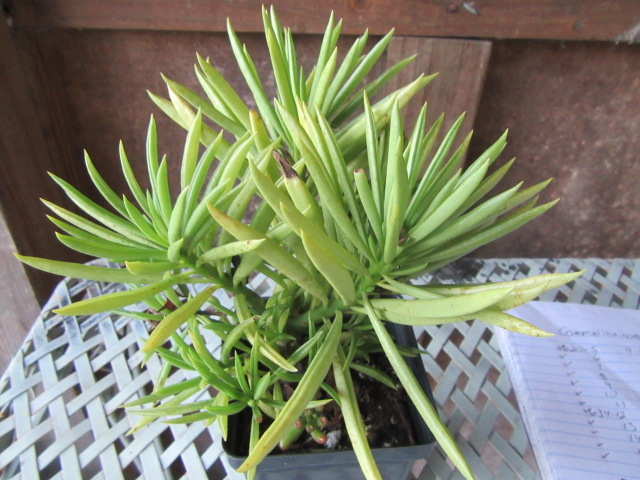
Peperomia ferreyrae at 6 1/2″ tall x 7 1/2″ wide on 10-23-23, #967-34.
I finally found another Peperomia ferreyrae at Wagler’s Greenhouse in May, so I had to bring it home. I brought my first one when I was living at the Mansion in Mississippi in 2012 and brought it with me when I moved back here in 2013. I don’t want to talk about what happened to it and most of my other plants, but it won’t happen again… It had nothing to do with my parents. Anyway, this plant has grown well over the summer and now measures 6 1/2″ tall x 7 1/2″ wide.
<<<<+>>>>

Stenocereus pruinosus (Gray Ghost/Organ Pipe) at 7 1/4″ tall x 3 1/4″ wide on 10-23-23, #967-36.
What would life be without the Stenocereus pruinosus (Gray Ghost)? One of the oldest in my cactus collection, now measuring 7 1/4″ tall x 3 1/4″ wide. I brought it home in 2016 when it was 2 7/8″ tall x 2 3/4″ wide. I like the way the pattern of gray bloom spreads out over the stem. It does need repotting like the rest of the cactus do… The coloration at the bottom is normal.
I lost a few last winter due to a mealybug issue still lingering from the plants that were shipped to me a few years ago. Sadly, the pair of Parodia lenninghausii and Echinopsis ‘Rainbow Bursts’ were among them, just as the Mammillaria pringlei and Mammillaria rhodantha were the year before. There have been a few more than that, but I really don’t want to talk about it.
There are a few more plants on the back porch I forgot to take until the 24th that will be on the next post, or maybe the next…
Until next time, be safe, stay positive, and always be thankful!





















